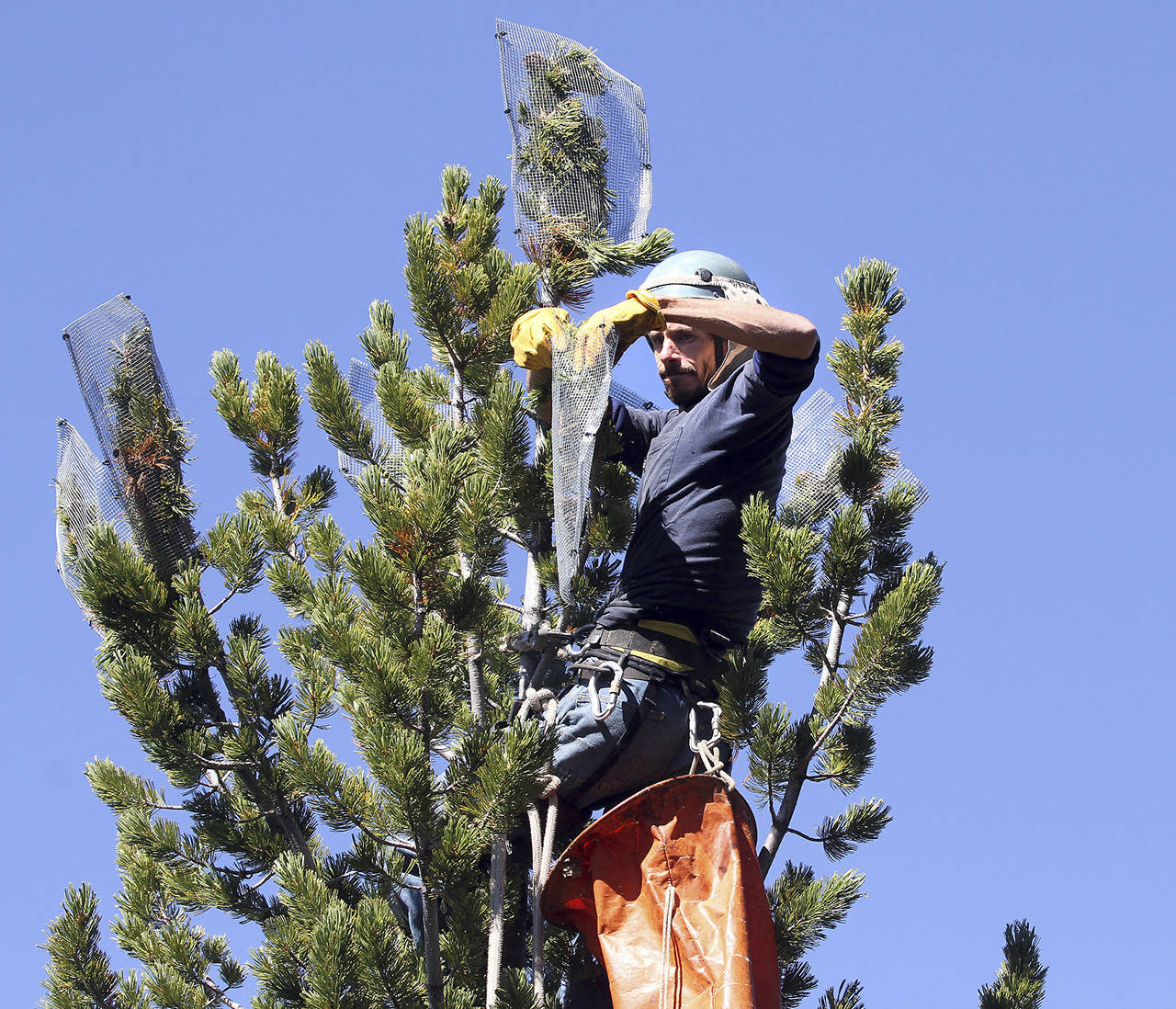By Matthew Brown / Associated Press
BILLINGS, Mont. — Climate change, voracious beetles and disease are imperiling the long-term survival of a high-elevation pine tree that’s a key source of food for some grizzly bears and found across the West, U.S. officials said Tuesday.
A Fish and Wildlife Service proposal scheduled to be published Wednesday would protect the whitebark pine tree as a threatened species under the Endangered Species Act, according to documents posted by the Office of the Federal Register.
But the agency said it does not plan to designate which forest habitats are critical to the tree’s survival, stopping short of what some environmentalists argue is needed.
The trees can live up to 1,000 years and are found at elevations up to 12,000 feet — conditions too harsh for most tress to survive.
Environmentalists had petitioned the government in 1991 and again in 2008 to protect the trees, which occur across 126,000 square miles of land in Wyoming, Montana, Idaho, Washington, Oregon, California, Nevada and western Canada.
A nonnative fungus has been killing whitebark pines for a century. More recently, the trees have proven vulnerable to bark beetles that have killed millions of acres of forest, and climate change that scientists say is responsible for more severe wildfire seasons.
The trees have been all but wiped out in some areas, including the eastern edge of Yellowstone National Park, where they are a source of food for threatened grizzly bears. More than half of whitebark pines in the U.S. are dead, according to a 2018 study from the U.S. Forest Service.
That has complicated government efforts to declare grizzlies in the Yellowstone area as a recovered species that no longer needs federal protection. Grizzlies raid caches of whitebark pine cones that are hidden by squirrels and devour the seeds within the cones to fatten up for winter.
A 2009 court ruling that restored protections for Yellowstone bears cited in part the tree’s decline, although government studies later concluded the grizzlies could find other things to eat.
After getting sued for not taking steps to protect the pine trees, wildlife officials in 2011 acknowledged that whitebark pines needed protections but they took no immediate action, saying other species faced more immediate threats.
An attorney with the Natural Resources Defense Council, which submitted the 2008 petition for protections, lamented that it took so long but said the proposal was still worth celebrating.
“This is the federal government admitting that climate change is killing off a widely distributed tree, and we know that’s just the tip of the iceberg. There are many species threatened,” said Rebecca Riley, legal director for the environmental group’s nature program.
The government’s proposal described the threats to whitebark pines as imminent and said it was one of many plants expected to be impacted as climate change moves faster than the plants can adapt.
“Whitebark pine survives at high elevations already, so there is little remaining habitat in many areas for the species to migrate to higher elevations in response to warmer temperatures,” Fish and Wildlife Service officials wrote.
The officials added that overall, whitebark pine stands have seen severe reductions in regeneration because of wildfires, a disease called white pine blister rust, mountain pine beetles and climate change.
Amid those growing threats, federal officials are working in conjunction with researchers and private groups to gather cones from trees that are resistant to blister rust, with plans to grow them in greenhouses and then plant them back on the landscape, said Fish and Wildlife Service biologist Amy Nicholas.
“We do have options to revive this species,” she said.
The decision not to pursue protections for the tree’s habitat is in line with another recent action by the Fish and Wildlife Service — the denial of critical habitat for t he endangered rusty-patched bumblebee.
The bumblebee’s population has plummeted 90 percent over about two decades. As with whitebark pine, loss of the bee’s habitat was considered less important than other threats.
The two cases underscore a pattern of opposition to habitat protections by the administration of President Donald Trump, environmentalists said.
The Fish and Wildlife Service under Trump also has proposed rules to restrict what lands can be declared worthy of protections and to give greater weight to the economic benefits of development.
“It’s clear that the intent is to limit protection of habitat for threatened and endangered species. Whitebark pine is another example of that,” said Noah Greenwald with the Center for Biological Diversity.
Fish and Wildlife Service Wyoming Field Supervisor Tyler Abbott said it would not be prudent to designate specific areas for habitat protections since the major threats to the trees can’t be addressed through land management.
“The driving factor (in the tree’s decline) is that white pine blister rust, and that’s working synergistically with mountain pine beetle, the altered fire regime, climate change,” Abbott said. “These are biological factors that we really don’t have any control over.”
Talk to us
> Give us your news tips.
> Send us a letter to the editor.
> More Herald contact information.

























